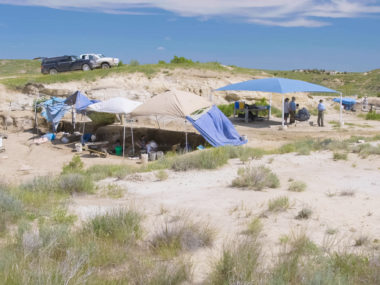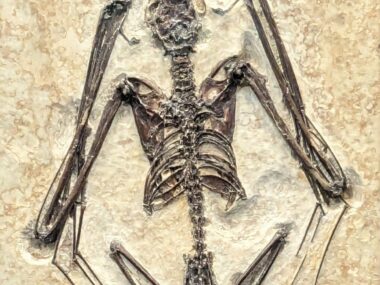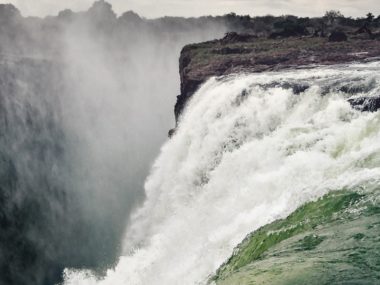Over the past several decades, many creationists have criticized the geologic column for its supposed ties to the evolutionary worldview. It is true that the geologic column utilizes biostratigraphy, which uses long-age and evolutionary assumptions. Other creationists have argued, however, that it is still a useful geologic tool. Timothy Clarey and Davis Werner of the Institute for Creation Research set out to test its validity. They examined the geologic column on a more global scale. They write that “the general pattern of the fossils within the geologic column remains a mainstay of secular geologic education and practice . . . And many creation geologists do support the notion of the geologic column, recognizing that many fossils do not reflect evolutionary patterns or time periods, but are indicative of the order of burial during a one-year, global Flood.”1 In other words, this paper asks can the geologic column be explained by Noah’s Flood?
The following article is a summary of “Global Stratigraphy and the Fossil Record Validate a Flood Origin for the Geologic Column” by Timothy Clarey and Davis Werner, and of the surrounding discussion and research pertaining to it. The views expressed do not necessarily reflect those of New Creation.
The Answers in the Strata
In addition to looking at the strata (rock layers) individually, it is also important to consider entire “packages” of strata. Geologists call these megasequences. Clarey, in a different article, describes them as follows:
“Megasequences supersede and include multiple geologic systems and in many instances can be recognized by their bounding erosional surfaces and sudden changes in rock type, independent of fossil content. Many creationists believe megasequences record the sedimentology of the Flood, while fossils record what flora and fauna was buried within each megasequence.”2
The paper they have written examines strata across North America, South America, and Africa to compare lithologic data. (Since the publication of this paper, they extended their studies to Europe and had similar findings). For each continent, they created a 3-D lithology model using the local columns. Using data from over 1500 sites, they constructed hundreds of stratigraphic columns for those continents. At each location, they recorded the complete record of sedimentary rocks from the surface down to the crystalline basement. They also included megasequence information in their model, to help give clues as to the depositional patterns as Flood water levels fluctuated throughout the course of the catastrophe. Since megasequence boundaries are quite distinct, they are traceable across large geographic areas. Clarey and Werner also note that the use of megasequences in their study lessens the dependence on the fossil record for their correlations.
Their discussion is technical and goes into much depth explaining the data and figures in their paper. To see their 3D models and descriptions, check out their full paper.
Implications on the Flood Boundary
From their models, they come to several interesting conclusions. It is important to note their conclusion regarding Flood boundaries. Though they mention that this was not the intent of their research, they noted their models seem to indicate a much later Flood/post-Flood boundary. This is one of the more debated topics in creationism. In certain areas of the world, the waters of the Flood perhaps would not have fully receded until the Late Miocene or even later!
The fossils from all of the continents studied indicated similar patterns as the sea level rose and fell throughout the Flood. What is quite fascinating is that “similar environments became entombed globally, creating a common and recognizable rock and fossil record across all continents.” So, the global biostratigraphic common quite famous for its consistent orderly sequence does fit within this Flood megasequence model! Additionally, these megasequences showcase the rises and falls of Flood waters throughout the catastrophic event. Their results show that massive lithologic units (like the Coconino!) are incredibly extensive, covering country-size regions. They conclude that “the fossils contained within the megasequences are merely the passive results of these major sedimentological events as the Flood waters rose higher and higher. Creationists should embrace the geologic column as it is robust evidence of a global Flood.”
Conclusion
Clarey and Werner have given us a good example of how data should be thoroughly examined and rigorously tested. It is then that data can give us a better understanding of Flood processes. Apparent conflicts in scientific models help to drive discovery!
Further Reading:
Footnotes
- Clarey, T. L., & Werner, D. J. (2018). “Global Stratigraphy and the Fossil Record Validate a Flood Origin for the Geologic Column,” The Proceedings of the International Conference on Creationism, 8, 327-350. ↩︎
- Clarey, T. (2015, March 31). “Grappling with Megasequences,” Retrieved February 18, 2021. ↩︎












Excellent article on excellent creationist researchers work. I like the conclusions BUT, always a but eh, the strata column must allow a post flood contribution to the strata levels in importance. I mean that great earth movements happened suddenly some centuries after the flood and finished in days or weeks. We need great volcanic eruptions to have destroyed life and fossilized it and laid strata levels down. Then a source for the sudden ice age.
One of the most important aspects of discussion of any contentious issue is the process of clarifying the definitions of terminology. I think that it is worth noting that the term “the geologic column” is generally understood to refer to something that cannot actually be observed to exist in any one geographical location. All we can observe is strata that are exposed in specific geographical locations or subterranean core samples that are extracted from specific geographical locations.
Hello Glenn,
It is true that the geologic column in its entirety cannot (usually) be found in any one place on the earth. Nevertheless, we know that the rock layers and fossils they contain are still found in a very consistent pattern all across the planet because we can cross-correlate the geologic column in one location to the geologic column in another location. This is important for young-earth geologists because it helps them map out the incredible extent of the layers (even across multiple continents!). It also helps them study the different geological processes at work before, during, and after the global Flood.
If one were not bound by needing to fit the evidence to a preconceived theory, the writer could simply have written: Creationists should embrace the geologic column as it is robust evidence of possible regional and perhaps global floods.” Am I not correct?
Hello Ron!
The way scientists use the word “evidence” is a tad different from how that word is used in common, everyday language. When a scientist says that something is evidence for a particular idea, they only mean that they have data that is consistent with that idea. So in the article above, the author is not saying that his research “proves” the Flood happened. Only that the data he has collected is very consistent with the global Flood scenario.
I recall being taught in Earth Science classes in the 70’s and 80’s about geosynclinal mountain building processes. When a geology professor was asked about “continental drift”( later called plate tectonics) as a mechanism for building mountains his response was…he didn’t want to think about that possibility because it sounded too catastrophic.
Recent trends in conventional geology seem more open to catastrophic processes. Perhaps time and reality have worked to remove some of the old biases against catastrophism.